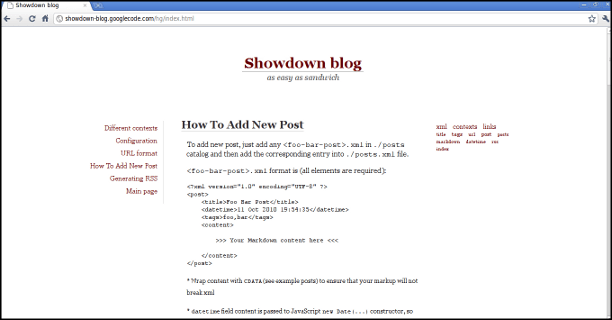Say you suddenly needed a personal blog. I already have some puny free hosting, and it hosting is puny for real, so it has no PHP and it even has no possibilities to set up any server-side at all. Or even worse, you have only a Dropbox account and in this very moment, suddenly, the personal blog is needed.
And more, may be you prefer to write you posts in Markdown-syntax instead of writing a heavy sad posts using dull HTML. The more, Markdown is now supported at a lot of places (excluding MSDN articles, may be). And there wouldn’t be out of place to store separate posts in separate files, so you can take one and copy-paste it in Tumblr or somewhere else. And it gives you a possibility to push files in some repository and to make your articles versioned this way…
And more, you’d like to have two versions of your blog in one entry point. English and russian, for example.
I think you now feel what I mean: I have a proposal for you abou this all. It’d be better to give more than one link already but I am an evil geek so I’ll put one in the end of article.
Picture

Components
Not to make things to hard, I’ve taken JQuery (I use only DOM-operations and a helper to load XML files asynchronously from it, so for the cruel need it can be accurately excised). Then I’ve taken Showdown, it is Markdown syntax parser moved to JavaScript. Then I’ve taken some strange dates parser (to display them nicely). And I’ve mixed all these stuff into one solid thing, so I’ve got a crazy little thing called JS/XML-driven blog engine. Easy as sandwich.
Receipt
To write your first post in a blog, get this package, unpack. Update your preferences (prefs.xml), create some post (posts/<post-id>.xml), add <post-id> in posts.xml. That’s all, you’re ready, post is published. For the next posts just repeat only last two steps. (In ./create.html you’ll find an editor that is ripped out from Showdown, and it will help your phantasy to imagine what Markdown-syntax parsing result will look like).
Now, once more
- Set up ising
prefs.xml - Put
some-post.xmlinpostsdirectory - Add
some-posttoposts.xml - Repeat steps 2 and 3 for next posts
Advantages
- Minimalism.
- No server side. At all.
- Posts are written with Markdown-syntax.
- One post - one XML file
- Configuration-over-XML
- Styles-over-CSS
- Tags, tags cloud and tags navigation
- Permalink for every post
- Supports mobile browsers (some)
- Several entry-points are supported
- RSS-generating script is included out-of-the-box
Disadvantages
- No commenting support
- No indexing with search engines
- Only for JavaScript-powered browsers
- Javascript and JQuery sometimes go slowly in slow networks
- If you have no
.htaccess, user must nameindex.htmlexplicitly - Things to optimize
May be later
- Paging
- Templates support
- More Nice RSS / RSS Automation
- Calendar
Example
Source code
Upd. Advantages and disadvatages had a bit changed through time, visit the project page to see how exactly they’ve changed.